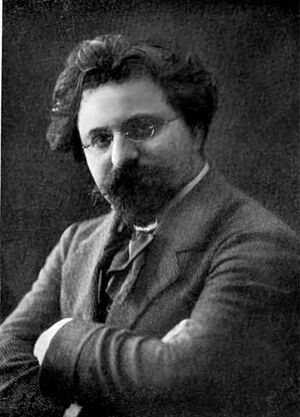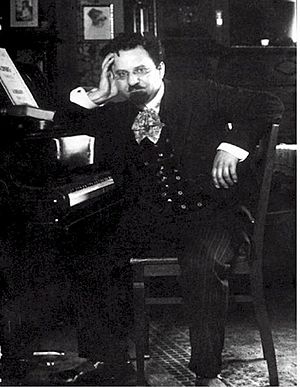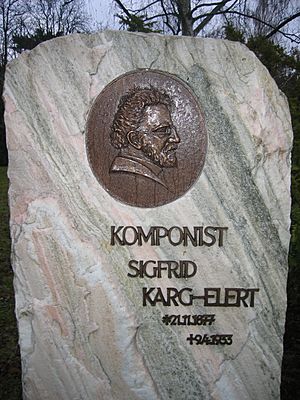Sigfrid Karg-Elert facts for kids
Sigfrid Karg-Elert (born November 21, 1877 – died April 9, 1933) was a German composer. He lived in the early 1900s. He is most famous for the music he wrote for the pipe organ and the reed organ.
Contents
About Sigfrid Karg-Elert
Sigfrid Karg-Elert was born as Siegfried Theodor Karg in Oberndorf am Neckar, Germany. He was the youngest of twelve children. His father was a book dealer or a newspaper editor.
His family moved to Leipzig in 1882. There, young Siegfried started learning music. He took private piano lessons.
Early Music Studies
Siegfried showed his first musical pieces to the composer Emil von Reznicek. Reznicek was impressed. He helped Siegfried get a three-year scholarship at the Leipzig Conservatory. This meant Siegfried could study music for free.
He learned from famous teachers like Salomon Jadassohn, Carl Reinecke, Alfred Reisenauer, and Robert Teichmüller.
Changing His Name
From 1901 to 1902, Sigfrid taught piano in Magdeburg. During this time, he changed his name to Sigfrid Karg-Elert. He added a part of his mother's maiden name, Ehlert, to his own. He also used the Swedish spelling of his first name, Sigfrid.
Focus on Composing
After returning to Leipzig, he spent his time writing music. He mostly wrote for the piano. The famous composer Edvard Grieg encouraged him.
In 1904, he met Carl Simon, a publisher. Simon introduced him to the harmonium. From then on, Karg-Elert wrote many important pieces for this instrument.
An organist named Paul Homeyer encouraged him to adapt his harmonium music for the organ. In 1909, he wrote his first original organ piece. It was called 66 Chorale Improvisations, Op. 65.
Family Life and Teaching
In 1910, Karg-Elert married Luise Kretzschmar. Their daughter, Katharina, was born four years later.
During World War I, he served as an oboist in the army. After the war, in 1919, he became a teacher. He taught music theory and composition at the Leipzig Conservatory.
From 1924, Karg-Elert gave weekly harmonium concerts on the radio from his home. He even played his second sonata for harmonium for his 50th birthday in 1927.
Later Years and Challenges
In the 1920s and 1930s, Karg-Elert's music was not very popular in Germany. His style was influenced by French music, which was not well-received there.
However, his music was admired in other countries, especially in the United Kingdom and the United States. The Organ Music Society of London held a festival in his honor in 1930.
In 1932, he went on an organ concert tour in America. This trip was difficult for him. He had health problems like nerve pain and heart issues. He also had diabetes, which was getting worse. His playing was not as strong as other famous organists of the time.
His Passing
After returning to Leipzig, his health quickly got worse. He passed away in April 1933, at the age of 55. He is buried in the Südfriedhof cemetery in Leipzig.
After World War II, his music became less popular for a while. But in the late 1970s, people started to appreciate his work again. Today, his organ pieces are often played in concerts.
Karg-Elert's Music Style
Karg-Elert saw himself as a unique composer. He was influenced by other great musicians. These included Johann Sebastian Bach (he often used the BACH motif in Bach's honor), Edvard Grieg, Claude Debussy, Max Reger, Alexander Scriabin, and early Arnold Schoenberg.
His music style is often described as late-romantic. It also has elements of impressionism (like painting with sounds) and expressionism (showing strong emotions). He knew a lot about music theory. This allowed him to create new harmonies while still keeping his music sound connected and clear.
Favorite Instruments
His favorite instruments to write for were the Kunstharmonium (a special type of reed organ) and the pipe organ. He also wrote for small groups of instruments and the piano. He even composed vocal music.
His music for the flute became very popular during his lifetime. He also showed a lot of interest in the saxophone.
Famous Works by Karg-Elert
Here are some of Sigfrid Karg-Elert's well-known compositions:
- 66 Chorale improvisations for organ (including "Nun danket alle Gott") Op 65
- Passacaglia in E-flat minor for harmonium or organ
- Cathedral Windows for organ
- Symphony in F-sharp minor op. 143 for organ
- 33 Stylistic Studies for harmonium
- Jugend for clarinet, flute, horn & piano
- 30 Caprices for flute solo
- Sonata for clarinet solo
- 20 Chorale Preludes and Postludes for organ
- 25 Caprices and an Atonal Sonata for saxophone
The Flute Caprices
The 30 Caprices for flute were written for a friend of Karg-Elert's. This friend was a flautist going to war. These short pieces were made to be challenging and interesting. They helped his friend stay sharp and avoid boredom. Today, these caprices are standard exercises for young flute students around the world. They help them learn technical skills, dynamics (louds and softs), and phrasing (how to shape musical lines).
Images for kids
See also
 In Spanish: Sigfrid Karg-Elert para niños
In Spanish: Sigfrid Karg-Elert para niños







